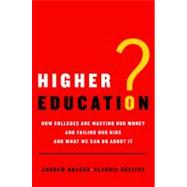What's gone wrong at our colleges and universities and how to get American higher education back on track
A quarter of a million dollars. It's the going tab for four years at most top tier universities. Why does it cost so much and is it worth it?
Renowned sociologist Andrew Hacker and New York Times writer Claudia Dreifus make an incisive case that the American way of higher education, now a $420 billion per year business, has lost sight of its primary mission: the education of young adults. Going behind the myths and mantras, they probe the true performance of the Ivy League, the baleful influence of tenure, an unhealthy reliance on part-time teachers, and the supersized bureaucracies which now have a life of their own.
As Hacker and Dreifus call for a thorough overhaul of a self indulgent system, they take readers on a road trip from Princeton to Evergreen State to Florida Gulf Coast University, revealing those faculties and institutions that are getting it right and proving that teaching and learning can be achieved and at a much more reasonable price.
“Andrew Hacker and Claudia Dreifus are sure to stir a badly needed uproar in the world of higher education. They make their argument so gracefully, with so much mischievous delight and understated humor, and undergirded by so broad a base of data and compelling reportage, that even the most furious defenders of the status quo will not be able to ignore this book and the outrage it most certainly will stir.”-Jonathan Kozol, author of Savage Inequalities and Letters to a Young Teacher
“A timely and provocative book about a subject that affects all of us. Higher Education? is a thoroughly researched and welcome addition to the debate.”-Joseph E. Stiglitz, Nobel laureate in economics
“Higher Education? stands out with facts, figures, and probing analysis. Andrew Hacker and Claudia Dreifus clearly lay out why so many colleges and universities are helping to support a de facto American class system while failing their primary mission of preparing not only skilled labor but also producing educated, knowledgeable citizens who can play a role advancing our national life and strengthening our democracy. This is a thought-provoking book that I hope will generate serious national debate.”-Vartan Gregorian, president, Carnegie Corporation of New York
“Higher Education? raises piercing questions about how a respected sector of our society is failing our young people. Andrew Hacker and Claudia Dreifus unsparingly show where our colleges and universities have lost their principles and purpose. This book will spark a national debate that has been lacking, but is nonetheless essential.”-The Rev. Theodore M. Hesburgh, president emeritus, University of Notre Dame








